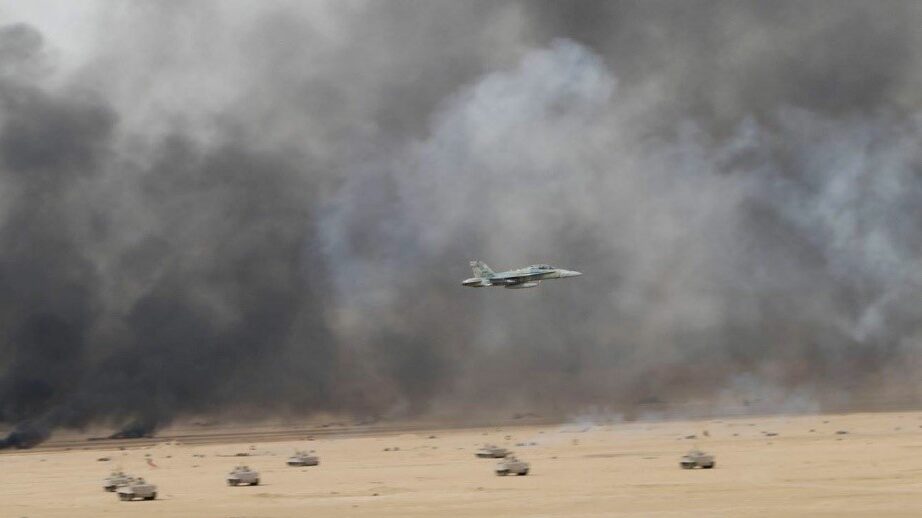
A Kuwaiti F/A-18 Hornet flies overhead as Kuwaiti Land Forces and 1st Battalion, 35th Armored Regiment conduct a combined live-fire demonstration on the ground during ‘Flagpole’ at Udari Range on January 22, 2018. (U.S. Army/Adriana M. Diaz- Brown)
DUBAI: The year 2022 was supposed to be the year the Kuwait Air Force took almost full delivery of two long-awaited platforms that would double its size and multiply its capabilities. However, delays caused by the COVID-19 global pandemic have pushed the delivery and operationalization schedule to 2023 — which may end up a blessing in disguise, as it has given Kuwait more time to figure out the fate of its current fleet of legacy F/A-18 Hornets.
The first two of 28 Typhoon jet fighters being built by Leonardo were delivered to the Kuwait Air Force last December, while the 28 F/A-18E&F Super Hornets Block 3 were reportedly delivered last September by Boeing to the US Navy. Kuwaiti pilots training on the Typhoons will start flying the fighters to Kuwait during this year and well into the next one.
Those jets will serve as a dramatic upgrade to Kuwait’s current capacity of 27 legacy F-18 Hornets, plus six F-18D trainers. By the end of 2023, the Kuwait Air Force would have doubled the size of its fixed-wing fleet of advanced fighters and significantly bolstered its capabilities.
But the original expectation was that more than half of the Typhoons and all of the Super Hornets would be in Kuwaiti hands by the end of 2022,
The COVID-19 shutdowns, which impacted supply chains and labor productivity in all industries worldwide starting in early 2020, also affected the work on the ground to build the necessary infrastructure to house and operate the fighters at two airbases in Kuwait.
“Acquiring the Super Hornet Block 3 and the Typhoon Tranche 3 standard warplanes will bolster the Kuwait Air Force capability and bring it to a whole new level,” said Ali Al Hashim, a Kuwait-based defense analyst. “But transferring the Super Hornets to Kuwait will take longer than planned due to the delayed infrastructure work at Ahmed Al Jaber Air Base because of the pandemic.”
Selecting the Super Hornet to replace the Hornets was a “natural and logical move,” according to Abdullah Al Foudary, the former Kuwait Air Force commander. The additional selection of the Typhoon, he said, came in line with a policy to “unify the platforms with other members of the Gulf Cooperation Council (GCC),” an alliance of Saudi Arabia, United Arab Emirates, Kuwait, Qatar, Bahrain, and Oman.
“Saudi Arabia and Oman had procured the Eurofighter Typhoon and Qatar was considering it and recently proceeded with the purchase,” Al Foudary said. “The idea here is that GCC air forces would be easily interoperable and will also be able to support one another with spare parts if they all purchased the same platforms.”
The Kuwait Air Force signed the $8.7-billion Typhoon contract with Leonardo back in 2017, and it included the purchase of 22 single-seaters and 6 double-seaters, plus training and operational support as well as building the infrastructure to house the warplanes at the Ali Al Salem Airbase.
The potentially $10 billion Foreign Military Sales contract with the US to purchase 22 F/A-18E single-seaters and 8 F/A-18F double seaters, with an option for 12 more units, plus a large package of weapons, sensors, and systems to the Hornet and Super Hornets, was signed in 2016. The US Navy awarded Boeing a $1.5-billion contract in 2018 to build the 28 Super Hornets.
Hashim pointed out that the Super Hornet deal took a while to come together because the Kuwait Air Force became aware of the upgrade to Block 3 and wanted to acquire this model’s specifications instead of Block 2.
“The Kuwait Air Force Super Hornets will have excellent features like the APG-79 AESA radars,” Hashim said.
As for the legacy F-18 Hornets, their fate is yet to be determined due to high demand from various countries.
Kuwait last year denied reports of a deal to sell its entire fleet to Malaysia, as was announced by government officials there. There were also press reports that Tunis was interested in acquiring the warplanes.
“Kuwait cannot sell the legacy Hornets to another country without the prior approval of the US Navy,” according to Hashim. “There are reports that the US Marines command appears to be interested in acquiring the Kuwait fleet of Hornets, and negotiations were underway between the two sides.”
With the Typhoons entering service along with the Super Hornets, Kuwait is once again operating European and American warplanes, as was the case before the 1990-91 Gulf War.
“Before the Iraqi invasion of Kuwait, the Air Force operated the US-made A-4 Skyhawk and the French Mirage F-1 fighters as its main warplanes, and now the Air Force has once again diversified its fleet,” Hashim said.
Al Foudary acknowledged the diversification policy and added that the Kuwait Air Force helicopter fleet is made up of several Eurocopter platforms, plus American-made Apache gunships.
The Kuwait Air Force appears to be on course to fulfill the plan it embarked on in 2016 to modernize and expand and is reportedly shopping for unmanned aerial vehicles for reconnaissance and attack missions and to enhance its ISR capabilities.
In a ‘world first,’ DARPA project demonstrates AI dogfighting in real jet
“The potential for machine learning in aviation, whether military or civil, is enormous,” said Air Force Col. James Valpiani. “And these fundamental questions of how do we do it, how do we do it safely, how do we train them, are the questions that we are trying to get after.”


























